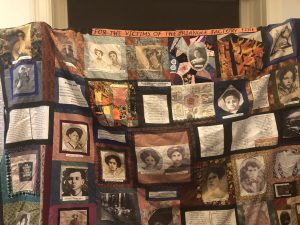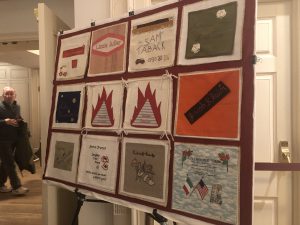 Emotions were raw while stories were shared at the Roosevelt House event that recalled the Triangle Shirtwaist Fire from 1911 and the art that has been created around it.
Emotions were raw while stories were shared at the Roosevelt House event that recalled the Triangle Shirtwaist Fire from 1911 and the art that has been created around it.
In “Remembering the Triangle Shirtwaist Factory Fire: Art as Activism” held last week at Roosevelt House, nine women presented stories and artwork inspired by the fire, including poetry, songs and quilts. When a fire broke out at the Triangle Shirtwaist Company on the Lower East Side in 1911, 145 workers were trapped and killed, largely because all the fire escapes were locked or chained shut. The fire brought attention to the dangerous working conditions in sweatshops and triggered changes in the law to protect workers.
Most of these women at the recent event here are members of the Remember the Triangle Fire Coalition, a group formed by activists to keep the history of women’s and workers’ rights alive and to educate others on this piece of history.
Robin Berson, a historian and author, has been making protest quilts throughout her career to show the lives lost in warehouse fires all over the world. She sews portraits of those lost with their names together on one big quilt.
“You don’t want to show corpses, there’s plenty of that,” Berson said. “You want to show human beings.”
Bracha N. Bomze read her poem to the crowd from her book “Love Justice.” The audience teared up as she told a story about her wife’s grandmother who was denied a job at the Triangle factory just weeks before it burned down. She cried when referencing that if she had gotten the job, she would not have met her wife. Her book is for sale at Roosevelt House for those who are interested in political poetry.
Emma Raynes spoke about Taslima Akhter, who is an activist in Bangladesh fighting to end the inhumane working conditions for garment workers there. She spoke about the Rana Plaza collapse that killed over 1,000 workers and sparked her activism career.
“They think of them [garment workers] like a number, not a human being,” said Akhter in an interview with Raynes.
Annie Lanzillotto and Rose Imperato, performers and activists, sang songs and excerpts from “The Ballad of Joe Zito,” “Triangle Fire Songbook” and “Schistsong.”
The presentations sparked interest in the audience, especially for Sarah Turk, 37, a Hunter student who attended the show.
“I really found the protest quilt idea, what’s actually been done, very interesting,” said Turk. “It’s something I want to learn more about.”
Others felt inspired by these women for their dedication and commitment to their cause and for fighting for those in these terrible working conditions and remembering those who have been lost already.

“I found it inspiring that whoever you are can do something to make a change and remember those who were lost,” said Allie Slomko, 30.
Other performances included LuLu LoLo, who gave a dramatic performance from “Soliloquy for a Seamstress;” Pamela Koehler, who gave a presentation about fiber arts; and Ruth Segel, who is the founder of Chalk. This event was run by professors in the women and gender studies program, Deborah Tolman and Carmelina Carteri.
Red Washburn, an English and women and gender studies professor at Hunter, brought her students so they could learn about the importance of women’s and labor rights and the ways in which art and activism bear witness.
“These women’s lives should never be forgotten, and we must continue to find ways to center their lives and work, especially in this political moment of rampant inequality,” said Washburn.

